Graduate Earnings by Major & Degree - University of Texas
Posted on 07/10/2018 by Beverly Kerr
- First-year median earnings for a graduate with a bachelor’s degree from UT-Austin range from $30,724 for a major in fine and studio arts to $119,936 for a major in petroleum engineering.
- First-year median earnings for a UT-Austin graduate with a bachelor’s degree in computer and information sciences is $85,334; a graduate of UT-Dallas with a similar degree will earn $64,919.
- Ten years post-graduation, a UT-Austin graduate with a MBA will be earning 74% more (in real, inflation-adjusted terms) than in his or her first year of work, while a graduate with a master’s in education will be earning only 28% more after 10 years.
- Today’s report features a new, innovative Census Bureau data set. While sustaining the anonymity of individual graduates/workers, it provides a big picture view of college transcript data linked to payroll records over time. UT is the first institution to complete a data sharing partnership agreement with the agency. Data for additional institutions will become available in the future.
Based on first-year post-graduation median annual earnings by field of study, University of Texas at Austin graduates with a bachelor’s degree in petroleum engineering enjoy higher salaries than bachelor’s degree earners of any other program in the University of Texas System. Six of the System’s top 10 best paid bachelor’s degrees are awarded by UT-Austin.

Ten years after earning a bachelor’s degree, petroleum engineering graduates from UT-Austin are still the best remunerated across the UT System. Of the 16 degrees with a median salary over $100,000, 10 years post-graduation, only 3 are awarded by other UT schools (2 engineering degrees from UT Arlington and a healthcare degree from UT Pan American).
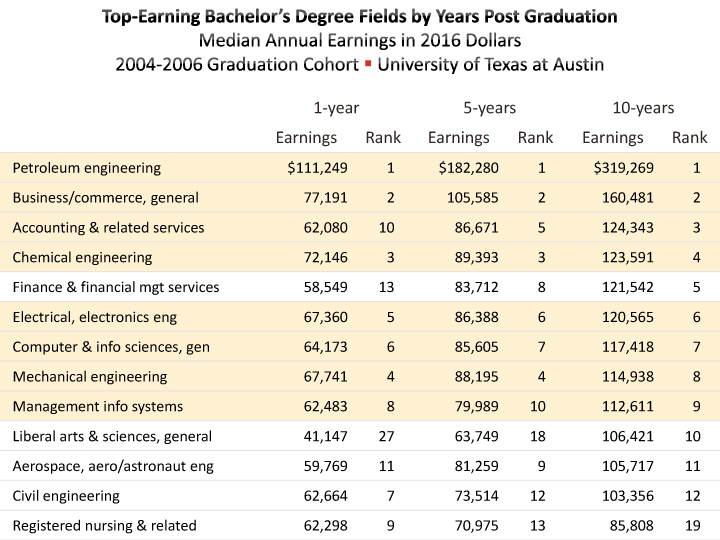
For UT-Austin’s top earning bachelor’s degree fields, 8 of the top 10 in the first year post-graduation are also in the top 10 5 years and 10 years out. The top earning fields skew heavily to science, technology, engineering and math (STEM), however, “liberal arts and sciences, general” is a notable exception among top earning UT-Austin awards at 10 years post-graduation.

The most recent UT-Austin cohort of bachelor’s degree earners, 2013-2015, are commanding higher real first-year post-graduation salaries than the preceding 2010-2012 cohort in nearly all fields. Of the 54 degree fields with earnings data in both cohorts, 3 are essentially unchanged and 6 are earning lower first year salaries than the previous cohort. The largest jumps in first year salaries among UT-Austin grads are seen by those earning bachelor’s degrees in “biochemistry, biophysics and molecular biology” and in “business administration, management and operations,” both up 21%. This business administration field is 1 of 5 reported in the business grouping for UT-Austin. It may be notable that 2 others, “business/commerce, general” and “accounting and related” are currently commanding lower real first-year salaries (3% and 5% respectively). See “Business, Management, Marketing & Related” section below for graphs illustrating additional data for this field.
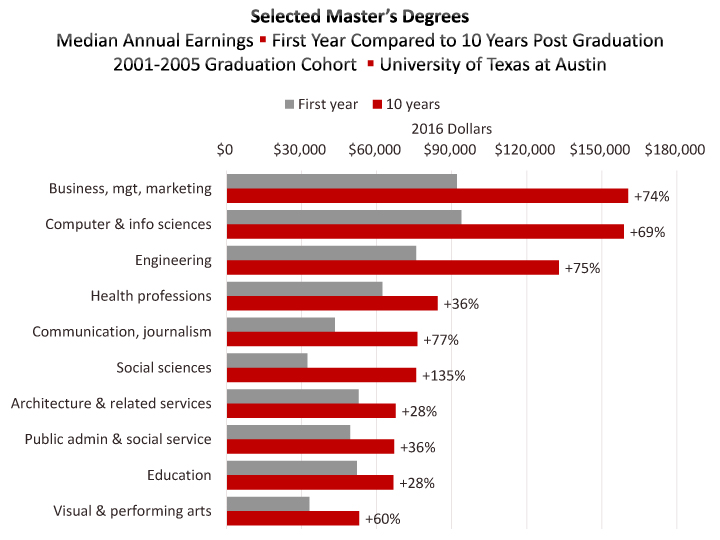
These numbers are produced by an innovative new data set, Post-Secondary Employment Outcomes (PSEO), developed by the Longitudinal Employer-Household Dynamics (LEHD) program at the U.S. Census Bureau. The initial release is limited to institutions in the University of Texas System.[1] Additional institutions will be added as data sharing partnership agreements are completed. Later this year, coverage of students within the Colorado Department of Higher Education will be added. The initial release is limited to earnings data, but later this year, data will be added on employment flows by region and industry for graduates by educational institution and major.
PSEO data provide earnings and employment outcomes for college and university graduates by degree level, degree major, and post-secondary institution. These statistics are generated by matching university transcript data with a national database employer payroll records, using state-of-the-art confidentiality protection mechanisms to protect the underlying data. Earnings are total annual earnings for attached workers from all jobs, converted to 2016 dollars using the CPI-U.
This new data enables prospective students to better understand the implications of their choice major and school. It’s also a valuable resource for companies and their recruiters in understanding the pool of new and experienced college grads and the salary ranges commanded by different degrees and majors. When flows of graduates from institution and major to region and industry of employment are added, a great deal of new and specific intelligence will be available. In the meantime, based on Linkedin insights,a large portion of recent graduates of UT-Austin are likley to remain in the Austin job market. For the 2013-2015 cohort, about 48% are in Austin. UT-Austin awards approximately 15,000 bachelor's and graduate degrees annually.
PSEO tabulates data for graduates in multi-year cohorts. Bachelor’s degree earners are reported in three-year cohorts (e.g., 2001-03; 2004-06; 2007-09; 2010-12; 2013-15). Graduate degree earners are reported in five-year cohorts (e.g., 2001-05; 2006-10; 2011-15). For each cohort, earnings is reported for the first year post graduation, plus 5 years and 10 years post-graduation.
Degree fields are reported according to the National Center for Education Statistics’ Classification of Instruction Program (CIP) taxonomic scheme. Fields of study can be reported at the 2-digit level, or in greater detail, at 4- or 6-digit classifications. For bachelor’s degrees fields, the PSEO degree field is defined at the 4-digit CIP code level, while master’s and doctoral fields are reported at the 2-digit level.
Many factors influence earnings, earnings gaps and the growth in earnings over time. A recent report published by the University of Texas and Georgetown University is Major Matters Most: The Economic Value of Bachelor’s Degrees from the University of Texas System. In addition to the importance of major, another factor highlighted in the report, with respect to earnings, is the performance edge accruing to more selective schools. The report classifies UT-Austin and UT-Dallas as selective colleges (admitting students who score in the top 35% of entrance exams) and the other UT schools as either middle-tier (admitting students who score above average on entry exams) or open-access.
Scroll below for graphs illustrating data for selected degree fields.
Computer & Information Sciences
The median earnings for UT-Austin graduates in the 2013-2015 cohort is 14% higher (in real, inflation-adjusted dollars) than the median earned by graduates in the 2010-2012 cohort.

It would be interesting to see the earnings of computer science graduates before 2001-2003 and the dot com recession, but we don’t have that data. It may be that the substantial 2004-2006 drop off in earnings in this occupation (and in electrical and electronic engineering, see below) reflects hangover from that early 2000s recession.

Based on real, inflation adjusted median earnings, a graduate who earned their bachelor’s degree in 2004-2006 was earning 33% more than their first year salary in year 5, and 83% more than their first year salary in year 10. The difference between the top and bottom quartiles of earners in the first year after graduation was 58%, but grew to 92% in year 10.

As noted above, many factors influence differences in earnings of graduates of different schools and programs. Austin’s and Dallas’ profiles as selective institutions may account for some of the edge in their graduates’ earnings over other schools. In addition, graduates classified in the CIP scheme as obtaining a degree in “computer and information sciences, general” or CIP 11.01, may not be completing precisely the same curriculum at different schools. This PSEO data set summarizes bachelor’s degrees at the 4-digit CIP level, which is not as granular as degrees can be classified.


Engineering

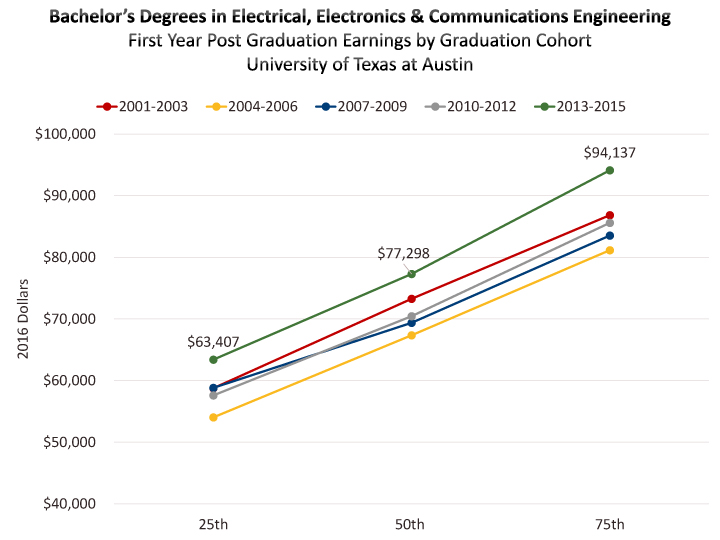
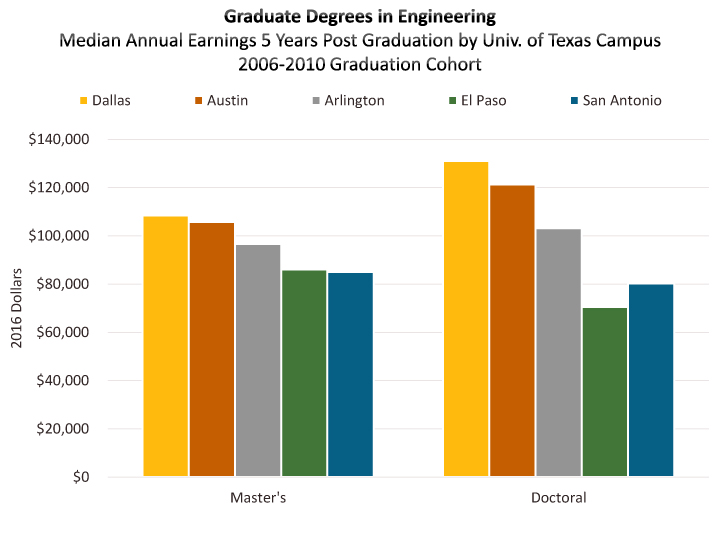
Business, Management, Marketing & Related


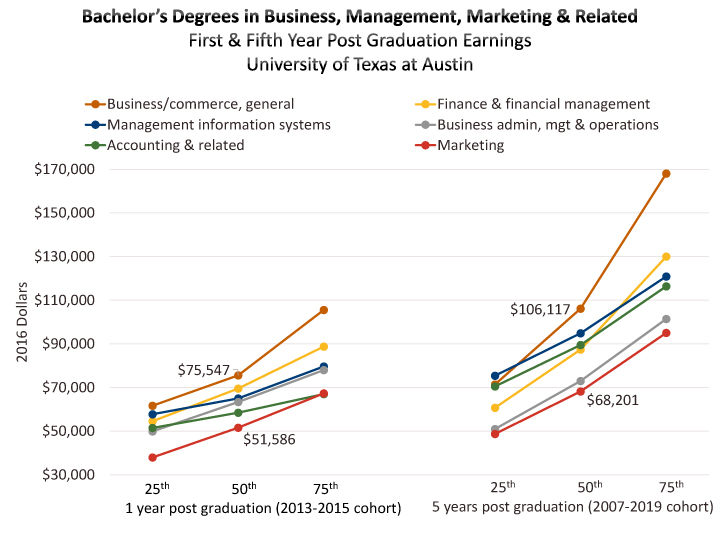
Education
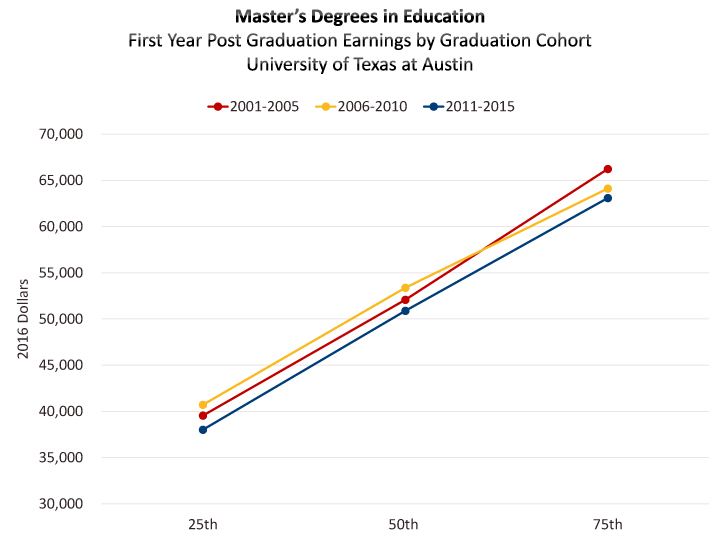

Nursing




Further Reading
- The Census Bureau’s and UT System’s press releases on PSEO.
- Articles on PSEO from Campus Technology and Higher Education Today.
- UT/Georgetown University report: Major Matters Most: The Economic Value of Bachelor’s Degrees from the University of Texas System.
- UT’s SeekUT online tool.
- Excel version of PESO’s graduate earnings data for UT System schools. If you have any interest in exploring this data further, all of the available data for all schools, graduate cohorts, degrees, etc., are in this single simple Excel sheet. Few datasets are simpler to use than this one. Just apply the filters set at the top of the sheet and you can readily look at exactly what you are interested in comparing.
FOOTNOTES:
[1] For several years, UT has deployed its own reporting system for graduate earnings called SeekUT. The partnership with the Census Bureau gives a more complete picture of post-college outcomes of UT graduates and PSEO data has been folded into the SeekUT app, which also provides data on student debt and other information geared to career guidance for prospective students.